#Margaret alice Murray
Text
Faites connaître vos décisions, jamais vos raisons. Vos décisions peuvent être bonnes, vos raisons seront certainement mauvaises.
0 notes
Text
Familiar Spirits and The Witches' Familiar - Coin's Notes
What is a familiar, and how do they fit into modern magic?


Definition
Familiars are spirits that act as assistants or guides to magic users, helping them with domestic and/or magical duties.
Familiars were and sometimes still are classified as a type of demonic spirit that often take the form of an animal, mostly thought to be cats, dogs, toads, and hares.
They are thought to help witches or magic users in domestic areas as well as in their magical affairs. Familiars can take on any color or shape.
In the 17th century, Familiars were more likely to be called “Imps”!
Etymology
The word Familiar comes from the Latin familiaris meaning "of or belonging to the family". Familiaris may come from the Latin word famulus meaning "slave" or "servant".
As far as we know, the first usage of the word in the context of witchcraft is attested from the 1560s. Before this, it was used as a noun meaning “familiar friend”.
History
The idea of familiars being a witch’s helper spirit was especially strong in the 17th century when King James I wrote about them in his book titled Daemonologie in which he talks about witches and their supposed "relations" with the devil.
This belief was most popular in East Anglian Europe and was scarcely found elsewhere during the witch trials.
The first recorded witch trial to reference a familiar in witchcraft is that of Dame Alice Kyteler, in 1324 (Wright 1833, p. 2) but it would be two centuries later that the idea of the witch's familiar took off.
Margaret Alice Murray talks about two different kinds of familiars The Witch-Cult in Western Europe: "those by which the witch divined and those who attended on the witch to obey her commands." *
Many historical accounts that we have regarding the confessions of supposed witches were likely falsified since the people being accused were under duress as they were being tortured. This doesn’t mean all historical accounts of Familiars are false, but we should take them with a grain of salt.
Most of the time those accused of witchcraft and of having "familiars" were lonely or isolated folks, likely older in age, that would talk to the animals probably similar to how we speak to our pets now.
However, keeping animals as pets wasn't too popular among the working class, and relationships with animals that were more than a farmer and his stock were seen as unnatural.
Cunning folk practices were said to involve familiars as well, though were often thought to be different than the witch’s “demonic” familiar and were sometimes referred to as the “fae” or “fairy” familiar in literature.
Side Note: We can’t talk about familiars without talking about demons!
“The noun meaning 'demon, evil spirit that answers one's call' is from the 1580s (familiar spirit is attested from 1560s); earlier as a noun it meant "a familiar friend" (late 14c.).
The Latin plural, used as a noun, meant ‘the slaves,’ also ‘a friend, intimate acquaintance, companion.’
The usual ancient Greek sense, ‘supernatural agent or intelligence lower than a god, ministering spirit’ is attested in English from the 1560s and is sometimes written daemon or daimon for purposes of distinction.
Meaning ‘destructive or hideous person’ is from the 1610s; as ‘an evil agency personified’ (rum, etc.) from 1712.” (etymologyonline)
Famous Familiars
Familiar spirits were confessed to during the witch trials of Huntingdon. Two of their names were Greedigut and Grissel and they were given to the witch in spirit form by a demon who went by the name Blackeman. They were said to look like black dogs with hoglike, bristled hair on their back.
-> It was said that they would do whatever their master requested and when they were not given a task would attack or rob passersby.
Agathion is a type of Familiar demonic spirit that can appear as an animal or a man. Once bound as a familiar it will live inside a ring or talisman of some sort. They were said to only appear at midday or to be most powerful at midday.
Sybacco was the familiar to the Comte de Corasse, the Comte de Foix, and Adriano Lemmi. Described as having bull horns and three eyes on his forehead, he is under the command of the demon Botiz.
Thomas "Tom" Reid was said to be the Familiar of Bessie Dunlop of Scotland, who was tried in 1576. Tom was described as the spirit of a soldier as well as an honest, elderly man. Tom told Bessie that he lived in Elfhame with the fae.
Boye was Prince Rupert’s dog that some believed to be his familiar due to their closeness and Boye’s tagging along during the British Civil War, though this was likely a smear campaign against the prince.
Similarities and Comparisons
Fylgr, a Norse guardian or “follower” spirit, was attached to a person related to their fate. These were often only seen by those with the ability to see the supernatural. In some cases, they would foretell the death of the person they followed but they weren’t inherently a sign of death.
Ancient Romans had genii that fall under the “helpful spirit” category, such as Lares Familiares which were household deities or spirits that were guardians of the family.
The Greeks believed in daimons which refer to supernatural beings between men and gods, such as minor gods or spirits of dead heroes.
-> Some believed you could have personal daimons that acted as guides, guardians, or spiritual companions. Socrates was said to have a personal daimon, see: De Genio Socratis.
Fetches, historically considered bad omens, are now sometimes seen as a servitor spirit with a time limit that a person creates for a specific purpose. The Fetch will disappear once their task is completed or they’ve been dismissed. (pg 63-66 Barbarous Words)
-> Originally, fetches were seen as a sort of spectral doppelganger, and seeing one foretold the death of the person they took the shape of.
Familiars in Modern Magic
Not dissimilar to their old definition, Familiars are seen as spirits that aid and guide witches. They are teachers, helpers, and companions.
Familiars can teach you magic, help with spells, or perform tasks for you.
They are not a pet. Treat a Familiar the way you’d treat a colleague or even a friend.
Divination is a great way to contact familiars. If you've done spirit work before then it's similar to contacting any other spirit.
Familiars are usually seen as a contractual spirit relationship.

Enjoy my posts? Consider leaving me a tip on my ko-fi!~
Resources and References
On Familiars
Familiar - Britannica
Etymology of Familiar - Etymology Online
Notes on Familiars by Early Modern Whale
Guardian spirits or Demonic Pets by James A Serpell
CunningFolk and Familiar Spirits by Emma Wilby
Paltrie Vermin, Cats, Mise, Toads, and Weasils: Witches, Familiars, and Human-Animal Interactions in the English Witch Trials. by Helen Parish
On the Witch Trials
Witch Persecutions edited by George L. Burr.
Malleus Maleficarum or The Witch’s Hammer by Heinrich Kramer and Jacob Sprenger
The Witch-Cult in Western Europe by Margaret Murray
Daemonologie by King James I
*Note: While her witch-cult theory has been thoroughly debunked, Murray helped shape modern witchcraft whether she meant to or not and as such her texts are worth a read.
Misc
Encyclopedia of Demons in World Religions and Cultures by Theresa Bane
The Folklore of Isle of Man ch. III by A. W. Moore
Barbarous Words: A compendium of Conjurations, British folk magic, and other Popish charms by George Hares
The Witch’s Familiar and the Fairy in Early modern England and Scottland
254 notes
·
View notes
Text
Kinda disappointed to see that Troy Books put out an edition of The Witch Cult of Western Europe, but I did learn that Margaret Murray's middle name isn't "Fucking", it is Alice.
18 notes
·
View notes
Text
Welcome to Letters2fiction!
The concept here is to send in a question or a letter request, and you’ll get a response from your fictional character of choice, from the list below. Please stick to the list I’ve made, but of course, you can ask if there’s some other characters I write for, I don’t always remember all the shows, movies or books I’ve consumed over the years and I’m sure I’m missing a lot 😅
Status: New Characters added - Thursday March 21st, 2024

TV SERIES
A Discovery of Witches:
Matthew Clairmont
Baldwin Montclair
Gallowglass de Clermont
Marcus Whitmore
Philippe de Clermont
Jack Blackfriars
Sarah Bishop
Emily Mather
Diana Bishop
Ysabeau de Clermont
Miriam Shepard
Phoebe Taylor
Gerbert D’Aurillac
Peter Knox
Father Andrew Hubbard
Benjamin Fuchs
Satu Järvinen
Meridiana
Law and Order:
Rafael Barba
Sonny Carisi
Joe Velasco
Mike Duarte
Terry Bruno
Peter Stone
Hasim Khaldun
Nick Amaro NEW!
Mike Dodds
Grace Muncy
Kat Tamin
Toni Churlish
Amanda Rollins
Olivia Benson
Rita Calhoun
Casey Novak
Melinda Warner
George Huang
Sam Maroun
Nolan Price
Jamie Whelan
Bobby Reyes
Jet Slootmaekers
Ayanna Bell
Jack McCoy
Elliot Stabler
One Chicago:
Jay Halstead (Could also be Will if you want)
Antonio Dawson
Adam Ruzek
Greg "Mouse" Gerwitz
Dante Torres
Vanessa Rojas
Kevin Atwater
Sean Roman
Matt Casey
Kelly Severide
Joe Cruz
Sylvie Brett
Blake Gallo
Christopher Hermann
"Mouch"
Otis
Violet Mikami
Evan Hawkins
Mayans MC:
Angel Reyes
Miguel
Bishop
Coco
Nestor
911 verse:
Athena Grant
Bobby Nash
Henrietta "Hen" Wilson
Evan "Buck" Buckley
Eddie Diaz
Howie "Chimney" Han
Ravi Panikkar
T.K. Strand
Owen Strand
Carlos Reyes
Marjan Marwani
Paul Strickland
Tommy Vega
Judson "Judd" Ryder
Grace Ryder
Nancy Gillian
Mateo Chavez
The Rookie:
Lucy Chen
Tim Bradford
Celina Juarez
Aaron Thorsen
Nyla Harper
Angela Lopez
Wesley Evers
BBC Sherlock:
Greg Lestrade
Mycroft Holmes
Sherlock Holmes
Moriarty
Molly
Bridgerton:
Anthony Bridgerton
Benedict Bridgerton
Simon Basset
Daphne Bridgerton
Eloise Bridgerton
Kate Sharma
Edwina Sharma
Marina Thompson/Crane
Outlander:
Jamie Fraser
Claire Beauchamp Randall Fraser
Frank Randall
Black Jack Randall
Brianna Fraser
Roger MacKenzie
Fergus Fraser
Marsali Fraser
Jenny Fraser Murray
Ian Murray Sr.
Ian Fraser Murray
Murtagh Mackenzie
Call The Midwife:
Shelagh Turner / Sister Bernadette
Dr. Patrick Turner
Nurse Trixie Franklin
Nurse Phyllis Crane
Lucille Anderson
Nurse Barbara Gilbert
Chummy
Sister Hilda
Miss Higgins
PC Peter Noakes
Reverend Tom Hereward NEW!
Narcos:
Horacio Carrillo
Peaky Blinders:
Tommy Shelby
Downton Abbey:
Robert Crawley, Earl of Grantham
Cora Crawley, Countess of Grantham
Lady Mary Crawley
Lady Edith Crawley
Lady Sybil Crawley
Violet Crawley, Dowager Countess of Grantham
Isobel Crawley
Matthew Crawley
Lady Rose MacClare
Lady Rosamund Painswick
Henry Talbot
Tom Branson
Mr. Charles Carson
Mrs. Hughes / Elsie May Carson
John Bates
Anna Bates
Daisy Mason
Thomas Barrow
Joseph Molesley
Land Girl:
Connie Carter
Reverend Henry Jameson (Gwilym Lee's version)
Midsomer Murder:
DCI Tom Barnaby
Joyce Barnaby
Dr. George Bullard
DCI John Barnaby
Sarah Barnaby
DS Ben Jones
DS Jamie Winter
Sgt. Gavin Troy
Fleur Perkins
WPC Gail Stephens
Kate Wilding
DS Charlie Nelson
Sergeant Dan Scott
NEW! Once Upon A Time
Regina / The Evil Queen
Mary Margaret Blanchard / Snow White
David Nolan / Prince Charming
Emma Swan
Killian Jones / Captain Hook
Mr. Gold / Rumplestiltskin
Neal Cassidy / Baelfire
Peter Pan
Sheriff Graham Humbert / The Huntsman
Jefferson / The Mad Hatter
Belle
Robin of Locksley / Robin Hood
Will Scarlet
Zelena / Wicked Witch
Alice (Once in Wonderland)
Cyrus (Once in Wonderland)
Jafar (Once in Wonderland)
Gideon
Tiger Lily
Naveen
Tiana
Granny
Ariel
Prince Eric
Aladdin
Jasmine
Dr. Jekyll and Mr. Hyde
Hercules
Megara
Tinker Bell
Merida
Red Riding Hood
Mulan
Aurora / Sleeping Beauty
Prince Phillip
Cinderella
Prince Thomas
NEW! The Vampire Diaries / The Originals
Stefan Salvatore
Damon Salvatore
Caroline Forbes
Elena Gilbert
Bonnie Bennett
Enzo St. John
Niklaus Mikaelson
Elijah Mikaelson
Kol Mikaelson
Rebekah Mikaelson
Freya Mikaelson
Finn Mikaelson
Mikael
Esther
Marcel Gerard
Davina Claire
MOVIES
The Pirates of the Caribbean:
Captain Jack Sparrow
Barbossa
Will Turner
Elizabeth Swann
James Norrington
Kingsman:
Merlin
Harry Hart
Eggsy Unwin
James Spencer / Lancelot
Alastair / Percival
Roxy Morton / Lancelot
Maximillian Morton / The Shepherd
Orlando Oxford
Jack Daniels / Whiskey
Gin
BOOKS
Dreamland Billionaire series - Lauren Asher:
Declan
Callahan
Rowan
Iris
Alana
Zahra
Dirty Air series - Lauren Asher:
Noah
Liam
Jax
Santiago
Maya
Sophie
Elena
Chloe
Ladies in Stem - Ali Hazelwood books:
Olive
Adam
Bee
Levi
Elsie
Jack
Mara
Liam
Sadie
Erik
Hannah
Ian
Fourth Wing - Rebecca Yarros:
Xaden Riorson
Dain Aetos
Jack Barlowe
Rhiannan Matthias
Violet Sorrengail
Mira Sorrengail
Lillith Sorrengail
Bodhi Durran
Liam Mairi
#a discovery of witches#law and order svu#law and order#law and order oc#chicago pd#chicago fire#mayans mc#911 abc#911 lone star#the rookie#bbc sherlock#sherlock#bridgerton#outlander#call the midwife#narcos#downton abbey#peaky blinders#land girls#midsomer murders#once upon a time#the vampire diaries#the originals#the pirates of the caribbean#kingsman#dreamland billionaires#dirty air series#love hypothesis#love theoretically#loathe to love you
31 notes
·
View notes
Text
for my beloved followers interested in mormon polygamy name discourse, i have compiled and presented a list of the children of four different 19th century mormon polygamist men, ranging from 30 to 66 children. I included middle names when I could find them and the children are listed in chronological order of their birth.
Brigham Young:
Elizabeth, Vilate, Joseph Angell, Brigham Jr., Mary Ann, Emma Alice, Luna Caroline, John Willard, Brigham Heber, Edward Partridge, Oscar Brigham, Hyrum, Joseph, Moroni, Mary Eliza, Ella Elizabeth, Alva, Alma, Fanny Decker, Emily Augusta, Marinda Hyde, Clarissa Maria, Jeanette Richards, Zina Presendia, Evelyn Louisa, Hyrum Smith, Caroline Partridge, Ernest Irving, Nabby Howe, Willard, Eudora Lovina, Mahonri Moriancumer, Emmeline Amanda, Shamira, Alfales, Brigham Morris, Phoebe Louisa, Jedediah Grant, Arta DeChrista, Joseph Don Carlos, Louisa Wells, Susa Amelia, Lorenzo Dow, Miriam, Albert Jeddie, Feramorz Little, Alonzo, Josephine, Clarissa Hamilton, Charlotte Tallula, Ruth, Phineas Howe, Lura, Daniel Wells, Rhoda Mabel, Adella, and Fanny van Cott
Heber Kimball:
Judith Marvin, William Henry, Helen Mar, Roswell Heber, Heber Parley, David Patten, Adelbert, Charles Spaulding, Henry, Brigham Willard, Sarah Helen, David, Margaret Jane, Abraham Alonzo, Isaac, Solomon Farnham, Samuel Chase, David Orson, Prescinda Celestia, Murray Gould, David Heber, Joseph Smith, Augusta, Cornelia Christine, John Heber, William Gheen, Susannah, Samuel Heber, Joseph Smith, Harriet, Newel Whitney, Willard Heber, Jacob Reese, Jonathan Golden, Horace Heber, Rosalia, Albert Heber, Lydia Holmes, Jedediah Heber, Hyrum Heber, Enoch Heber, Peter, Daniel Heber, Ann Spaulding, Sarah Maria, Jeremiah Heber, Mary Melvina, Andrew, Alice Ann, Eliza, James Heber, Joshua Heber, Washington, Mary Margaret, Moroni Heber, Sarah Gheen, Joshua Heber, Eugene, Wilford Alfonzo, Franklin Heber, Lorenzo Heber, Abbie Sarah
Joseph F. Smith:
Mercy Josephine, Sarah Ellen, Mary Sophronia, Leonora, Hyrum Mack, Donette, Joseph Richards, Alvin Fielding, Heber John, Joseph Fielding Jr., Alfred Jason, Rhoda Ann, David Asael, Edna Melissa, Minerva, Albert Jesse, George Carlos, Alice, Robert, Julina Clarissa, Willard Richards, Elias Wesley, John Schwartz, Franklin Richards, Emma, Emily Jane, Lucy Mack, Calvin Schwartz, Zina, Rachael, Jeanetta, Samuel Schwartz, Andrew Kimball, Ruth, Edith Eleanor, James Schwartz, Jesse Kimball, Asenath, Martha, Agnes, Silas Schwartz, Fielding Kimball, and Royal Grant
Parley Pratt:
Parley Parker Jr., Nathan, Olivia Thankful, Susan, Moroni Llewellyn, Alma, Helaman, Nephi, Julia Houston, Belinda Marden, Cornelia, Agatha, Abinadi, Lucy, Ether, Mormon, Mosiah, Malona, Lehi Lee, Henriette, Marian, Omner, Teancum, Mary Wood, Moroni Walker, Phoebe Soper, Isabella Eleanor, Sarah Elizabeth, Evelyn, Mathoni
also who had the best name taste and who had the worst
#i dont know whether parley pratt nerfing literally every single one of his sons except nathan with a terrible name or heber kimball naming#almost all of his sons after himself is worse. lol#HK didn't have as many just batshit insane names but he was also terminally uncreative and had the most repeat names between siblings#including TWO sets of living siblings with the same exact full name which is demonic#i would argue that Joseph F. Smith probably had the best taste in names. he was a generation younger so i guess they settled down a bit
21 notes
·
View notes
Text
Wikipedia Featured Article Poll, Biographies Edition. Summaries and links below the cut
Margaret Ives Abbott (June 15, 1878 – June 10, 1955) was an American amateur golfer. She was the first American woman to win an Olympic event: the women's golf tournament at the 1900 Summer Olympics.
Lilias Eveline Armstrong (29 September 1882 – 9 December 1937) was an English phonetician. She worked at University College London, where she attained the rank of reader. Armstrong is most known for her work on English intonation as well as the phonetics and tone of Somali and Kikuyu. Her book on English intonation, written with Ida C. Ward, was in print for 50 years. Armstrong also provided some of the first detailed descriptions of tone in Somali and Kikuyu.
Morris Berg (March 2, 1902 – May 29, 1972) was an American catcher and coach in Major League Baseball, who later served as a spy for the Office of Strategic Services during World War II. Although he played 15 seasons in the major leagues, almost entirely for four American League teams, Berg was never more than an average player and was better known for being "the brainiest guy in baseball." Casey Stengel once described Berg as "the strangest man ever to play baseball".
Edward Dando (c. 1803 – 28 August 1832) was a thief who came to public notice in Britain because of his unusual habit of overeating at food stalls and inns, and then revealing that he had no money to pay. Although the fare he consumed was varied, he was particularly fond of oysters, having once eaten 25 dozen of them with a loaf and a half of bread with butter.
Harold Francis Davidson (14 July 1875 – 30 July 1937), generally known as the Rector of Stiffkey, was a Church of England priest who in 1932, after a public scandal, was convicted of immorality by a church court and defrocked. Davidson strongly protested his innocence and to raise funds for his reinstatement campaign he exhibited himself in a barrel on the Blackpool seafront. He performed in other sideshows of a similar nature, and died after being attacked by a lion in whose cage he was appearing in a seaside spectacular.
Marjory Stoneman Douglas (April 7, 1890 – May 14, 1998) was an American journalist, author, women's suffrage advocate, and conservationist known for her staunch defense of the Everglades against efforts to drain it and reclaim land for development. Moving to Miami as a young woman to work for The Miami Herald, she became a freelance writer, producing over one hundred short stories that were published in popular magazines. Her most influential work was the book The Everglades: River of Grass (1947), which redefined the popular conception of the Everglades as a treasured river instead of a worthless swamp. Its impact has been compared to that of Rachel Carson's influential book Silent Spring (1962). Her books, stories, and journalism career brought her influence in Miami, enabling her to advance her causes.
George Went Hensley (May 2, 1881 – July 25, 1955) was an American Pentecostal minister best known for popularizing the practice of snake handling. A native of rural Appalachia, Hensley experienced a religious conversion around 1910: on the basis of his interpretation of scripture, he came to believe that the New Testament commanded all Christians to handle venomous snakes.
Margaret Alice Murray FSA Scot FRAI (13 July 1863 – 13 November 1963) was a British-Indian Egyptologist, archaeologist, anthropologist, historian, and folklorist who was born in India. The first woman to be appointed as a lecturer in archaeology in the United Kingdom, she worked at University College London (UCL) from 1898 to 1935. She served as president of the Folklore Society from 1953 to 1955, and published widely over the course of her career.
Dom Pedro Afonso (19 July 1848 – 10 January 1850) was the Prince Imperial and heir apparent to the throne of the Empire of Brazil. Born at the Palace of São Cristóvão in Rio de Janeiro, he was the second son and youngest child of Emperor Dom Pedro II and Dona Teresa Cristina of the Two Sicilies, and thus a member of the Brazilian branch of the House of Braganza. Pedro Afonso was seen as vital to the future viability of the monarchy, which had been put in jeopardy by the death of his older brother Dom Afonso almost three years earlier.
Elias Abraham Rosenberg (Hebrew: אליאס אברהם רוזנברג; Hawaiian: Eliaka Apelahama Loselabeka; c. 1810 – July 10, 1887) was a Jewish immigrant to the United States who, despite a questionable past, became a trusted friend and adviser of King Kalākaua of Hawaii. Regarded as eccentric, he lived in San Francisco in the 1880s and worked as a peddler selling illegal lottery tickets. In 1886, he traveled to Hawaii and performed as a fortune-teller. He came to Kalākaua's attention, and endeared himself to the king with favorable predictions about the future of Hawaii. Rosenberg received royal appointments to several positions: kahuna-kilokilo (royal soothsayer), customs appraiser, and guard. He was given lavish gifts by the king, but was mistrusted by other royal advisers and satirized in the Hawaiian press.
#i expanded the summaries from the first sentence of the article to the first paragraph#cause with some of these people you don't get the full effect from just the first sentence#and also cause it's my poll.#Wikipedia polls
23 notes
·
View notes
Text
"My fingers are like arrows. My arms like iron. My feet like spears."
After seeing Butcher Billy's poster with the party and Erica on it + her holding a green arrow that points at Mike & Will (AND the heart between them. ON the shield. Their love is the shield = it may be the only protection against Vecna), I also paid particular attention to another one. Murray's poster.
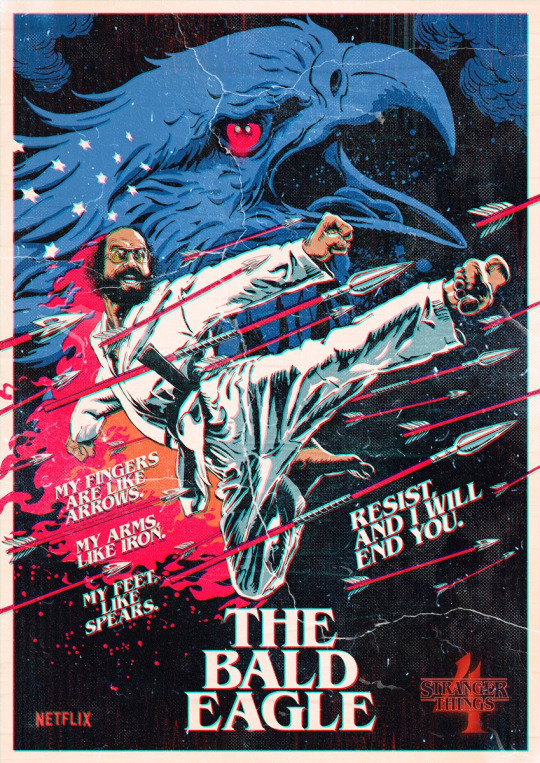
What about it, you may ask me. First of all, the eagle's eye reminds me of a heart. The second thing - the fire behind Murray. The fire is associated with Will (because of the fireballs). And, of course, the arrows. Not only the arrows drawn on the poster but the ones from the phrase we see on it too. If I'm not mistaken he says these words to Yurii on the plane before knocking him out. Now may I present to you my delusional rumblings (but with Erica holding that arrow and Mike being associated with arrows it kinda makes a little sense to me).
Fingers = arrows. How many fingers do we have? Twenty. What number did Erica roll in 1x04 and defeat Venca with it? Twenty.
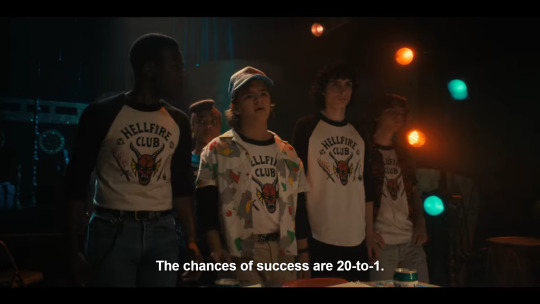
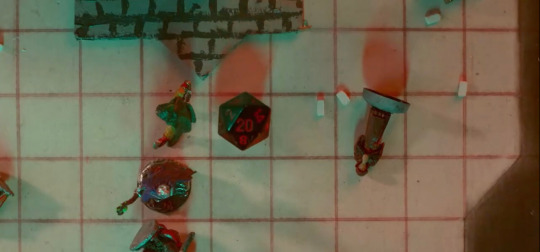
But this also may be connected to eightfifteengate, because 20:00 is 8 p.m. and Vecna has 25 hit points left.



The party's 20 against Vecna's 15. 20:15. 8:15 p.m.
Feet = spears. They're associated with Sinclair's siblings.
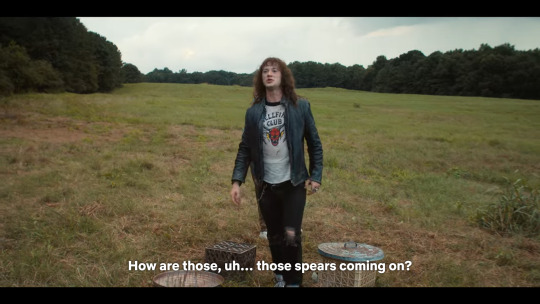
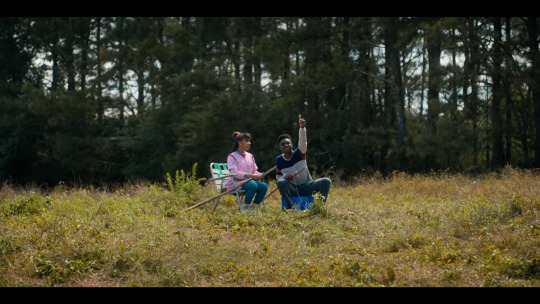
These two were substitutes in their games. Lucas was always on the bench and Erica was not taken as a serious player by Eddie BUT THESE TWO BROUGHT VICTORY FOR THEIR TEAMS.


Again, it’s Erica who rolled that 20. It’s not the first time the Duffers use her for foreshadowing (I’m adding links for Nintendo theory and my other posts about Erica for those who’re really interested), but also Lucas. He will play an important part in s5 for sure. But also it's Lucas who's associated with the Coke metaphor where Regular Coke = Milkvan = bones and New Coke = Byler = endgame (credit to @awhstrangerthings!!!!).
Arms = iron. I don’t have in mind any mention of iron in the show. There was that talk between Jonathan and Argyle about different types of wheels after the Rink-o-Mania fight and they did mention metal wheels. BUT I recalled my another post in which I wrote about the Wheeler’s house being called “a princess castle” and Nancy was being referred to as a princess in s1. So, is Mike a prince then, huh? The Frog Prince? (because he’s called “frogface” by the bullies at school). Another name for this fairy tale is Iron Henry. IRON HENRY. Another Wheelers/Creels connection.

“the first story” and “a German fairy tale.” Henry was 001 - the first Brenner's test subject - before becoming Vecna. Troy talks about fairyland and fairies while calling Will gay in s1
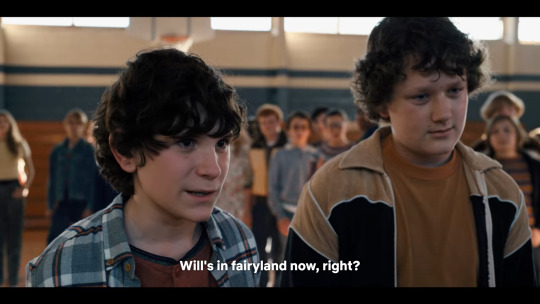


And Steve compares Mind Flayer (they don’t know about Henry/001/Vecna at that time) to Germans (before Dustin corrects him it’s the Nazis) in s2.



And here the gates remind of the swastika used by the Nazis.

+ Margaret Thatcher is known as the “Iron Lady” and who mentions her in s2? Karen Wheeler.


Again, iron is associated both with Wheelers and Creels (Henry in particular), but also we have this parallel:


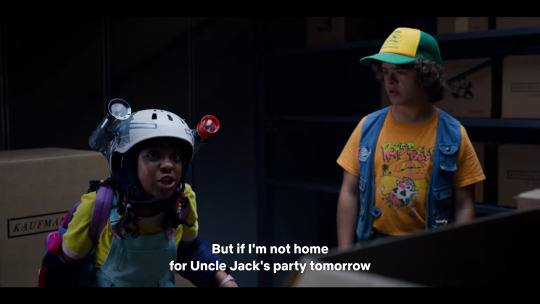
Tina's party -> Uncle Jack's party at Tina -> TINA is an acronym for the phrase "there is no alternative." The idea is that only one course of action is possible. This slogan is often attributed to Margaret Thatcher.
Uncle Jack is Jack Sparrow's uncle in the film "Pirates of the Caribbean: Dead Men Tell No [fairy] Tales." He is a pirate who is recently imprisoned in Saint Martin's prison. And if Karen happens to be Alice Creel, Henry/001/Vecna will be Nancy's, Mike's and Holly's uncle. Jack is also a playing card bearing a representation of a soldier, page, or knave, normally ranking next below a queen -> "I will be king, you will be queen" = Byler, which makes Vecna less powerful than each of them.
"Resist, and I will end you."
Isn't it about Mike experiencing internalised homophobia, being unwilling/too scared to accept his sexuality and resisting his true self that makes him such an easy target for Vecna? Him singing "Never Surrender" while making out with El just proves it. "Cause no one can take away your right to fight and to never surrender" - he's fighting with himself and he's going to try his best to be -- as Finn said -- as normal as possible, hiding his true self and his true feelings toward his best friend. The other song we hear during the Milkvan makeout scene, interrupted by Hopper's attempt to have a heart-to-heart with them is "Can't Fight This Feeling." Just read the lyrics and tell me it's not about Mike & Will and after that look here (YES I've made five (actually it's six) posts related to this song BUT ALL THESE PARALLELS ARE CRAZYYYYYY and the posts are mostly screenshots so it won't take you much time to check it out.
I can't fight this feeling any longer
And yet I'm still afraid to let it flow (Mike finds it harder and harder to fight his feelings toward Will, trying to project it onto El and he's afraid to come out of the closet + flow = water reference)
What started out as friendship has grown stronger
I only wish I had the strength to let it show (Mike feels they're more than friends because he interprets "What about us?" romantically, answering "We're friends! We're friends.")
I tell myself that I can't hold out forever
I said there is no reason for my fear
'Cause I feel so secure when we're together (When it comes to Will, it's always "we" and "together" for Mike: "- We have to kill him. - And we will. We will." and "- Hey Will, if we'll both go crazy, we"ll go crazy together? - Yeah, crazy together.")
You give my life direction
You make everything so clear (Mike's arrow pocket, located on his heart pointing at Will as a compass)
And even as I wander
I'm keeping you in sight (Even when he's dating El, he's still thinking and worrying about Will to the point that he states Will "moping, rolling your eyes, barely talking" at Rink-o-Mania and not noticing El being afraid of her bullies and being fake)
You're a candle in the window
On a cold, dark winter's night (Will is always in light in Mike's POV in s4 and, as I already mentioned, he's associated both with light and with fire)
And I'm getting closer than I ever thought I might
And I can't fight this feeling anymore
I've forgotten what I started fighting for
It's time to bring this ship into the shore
And throw away the oars, forever (Water references my beloved that are still a mystery for me, but they're EVERYWHERE)
'Cause I can't fight this feeling anymore
I've forgotten what I started fightin' for
And if I have to crawl upon the floor
Come crashing through your door (1x05: The Crawl and Mike "crawling back" to Will instead of El "begging for forgiveness" in s3)
Baby, I can't fight this feeling anymore
So Michael, sweetie, PLEASE, stop fighting, stop resisting and let the gay love defeat Vecna!
#byler#mike wheeler#will byers#stranger things#stranger things 4#stranger things theory#murray bauman#erica sinclair#lucas sinclair#the wheelers and the creels#vecna#stranger things soundtracks#stranger things songs#stranger things music#stranger things parallels#st & compasses
72 notes
·
View notes
Note
https://www.findagrave.com/memorial/133227825/margaret-alice-murray
says here she was cremated. family probably kept the ashes or spread them somewhere.
Oh that bitch.
7 notes
·
View notes
Text
Author Statistics
For 10 authors, I read their works into the double digits:
Alessandra Hazard (x11)
Kiki Clark (x12)
Kati Wilde (x13)
Shelly Laurenston (x15)
AJ Sherwood (x16)
Onley James (x20)
KL Noone (x24)
Charity Parkerson (x31)
Megan Derr (x40)
Mary Calmes (x44)
For 24 authors, I read at least 3 and at most 9 works:
Andrea K Host (x4), Anne Bishop (x4), Brigham Vaughn (x3), Bruce Sentar (x3), Deacon Frost (x3), Eric Ugland (x7), Gail Carriger (x1)/GL Carriger (x3), Ilona Andrews (x5), Jennifer Cody (x4), Jordan Castillo Price (x3), Louisa Masters (x6), Lucy Lennox (x5), Lyn Gala (x3), Mell Eight (x3), Michelle Diener (x4), Naomi Novik (x3), R Cooper (x5), RJ Moray (x2)/Robin Moray (x1), Sam Burns (x5), Shirtaloon (x7), Stella Starling (x4), TJ Land (x9), Vasily Mahanenko (x3), and Wen Spencer (x5).
For 25 authors, I read exactly 2 works:
Alex Gilbert, Alice Winters, Amanda Meuwissen, Amy Crook, Andy Gallo, Bettie Sharpe, Claire Cullen, David North, Eli Easton, Eryn Ivers, Isabel Murray, Jessie Mihalik, KM Neuhold, LC Mawson, Luke Chmilenko, Macronomicon, Ofelia Grand, Robin Roseau, Ryan Rimmel ,Sam Burns & WM Fawkes (with Sam Burns), Shannon West, Skylar Jaye, Tara Lain, TS Snow, and Victoria Helen Stone.
For 87 authors, I read only a single work:
A Catherine Noon & Rachel Wilder, AC Wiggen, Allie Brosh, Amanda Milo, Andrea Speed, Anyta Sunday (with Andy Gallo), April Jade, Arden Powell, August, Brea Alepou & Wren Snow, Brooke Matthews, Bryce O’Connor (with Luke Chmilenko), Cale Plamann, Casualfarmer, Catelyn Winona, Chace Verity, CJ Carella, CM Blackwood, Courtney Milan, Daniel Rose, Danny M Lavery, Darktechnomancer, Dassy Bernhard, Delaney Rain, Delmire Hart, Devon Vesper, DI Freed, DM Rhodes, Eden Finley & Saxon James, EJ Russell, Elliott Kay, EM Lindsey (with Kiki Clark), Hayden Hall, HJ Tolson, Jenny Lawson, Jesse Q Sutanto, JK Jeffrey, KA Merikan, Kaleb England, Kaydence Snow, Kou Delika, Lee Hadan, Liz Talley, May Archer (with Lucy Lennox), Macy Blake, Margaret Atwood, Marie Cardno & Kalikoi, Michele Notaro, Michelle Frost, Michelle Kathleen Hodgson, Natasha Hunter, Nazri Noor, Philip R Johnson & Justin C Louis, Raleigh Ruebins, Ravensdagger, Regine Abel, Riley Hart, RJ Scott, Robert Bevan, Ryn Bretcher, Sam Starbuck, Samantha Cayto, Sariah Wilson, Sasha L Miller, Scott Browder, SE Harmon, Sean Oswald, Sebastian Hansen, Seth Richter, Sienna Sway, Sierra Riley, SJ Himes, Stephanie Burgis, Stephen L Hadley, Stuart Grosse, Suki Fleet, Sunny Hart, SunriseCV, Tansy Rayner Roberts, Tanya Chris, Toby Wise, Tom Watts, Toni McGee Causey, Travis Baldtree, Xander Boyce, Yamila Abraham, and Zile Elliven.
5 notes
·
View notes
Text
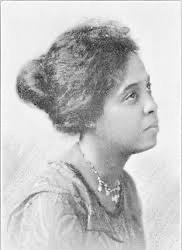
Alice Carter Simmons (March 1883 – March 30, 1943) was a pianist, organist, and music educator. She was the founding secretary of the National Association of Negro Musicians and was head of the instrumental music program at Tuskegee Institute; she taught at Fisk University.
She was born in Hollandale, Mississippi, the daughter of Emory Peter Simmons and Willie Murray Simmons. Her father, born enslaved was a school principal. Her aunt Margaret Murray Washington was the third wife of Booker T. Washington. Her brother was journalist and lecturer Roscoe Simmons.
She completed teacher training at Tuskegee Institute, graduated from Fisk University, and pursued further training as a pianist at the Oberlin Conservatory of Music, completing a BSM. She was working on a master’s degree at Columbia University.
In 1910, she played the first night concert to open the Morton Theatre. She was on the faculty of the Elizabeth City State Teachers College (1910-11). She became head of the division of instrumental music at Tuskegee Institute (1916). One of her Tuskegee students was composer William L. Dawson. She accompanied singer Cleota Collins and violinists Clarence Cameron White and H. Harrison Ferrell in concerts at Tuskegee.
She helped organize a choir competition at Fisk University (1931). She became secretary-treasurer of NANM (1922) remained on the board through the mid-1920s, and was active at the organization’s national conventions into the 1930s.
In her last years, she was director of Club Caroline, a residence for Black working women in New York City.
In 1944, the Los Angeles chapter of the NANM held a memorial concert for her and her colleagues Robert Nathaniel Dett and Maude Roberts George. Naida McCullough was one of the musicians featured. #africanhistory365 #africanexcellence #womenhistorymonth
0 notes
Photo

August 8, 2020 | “The Creepy Quandary of Who Put Bella in the Wych Elm” (2020)
From the YouTube channel Buzzfeed Unsolved Network, I watched the video about the skeletal remains—nicknamed Bella—discovered in a wych elm in England by four boys. There are several theories on how the remains got in the tree; one theorist was the Egyptologist Dr. Margaret Murray. Her theory was that witchcraft was involved, and the deceased was a human sacrifice.
According to FemBio.org, Murray was an “English Egyptologist, archaeologist, lecturer, author, feminist, [and] folklorist.” This online biography begins with the quotation from her book My First Hundred Years (published in 1963 by W. Kimber): “My third attempt [to find a career] was Egyptology, and from that I have never wavered.”
While excavating at Abydos, Margaret Murray uncovered the Osireion, a temple to the god Osiris. Her site report, The Osireion at Abydos, was published in 1904. The report was considered ground-breaking. In addition to detailed descriptions of the site and many transcriptions of writing and copies of ornamentation, she—always interested in the cultural side of archaeology—included her study of the god Osiris and associated legends, beliefs, and ceremonies. Murray returned to Egypt in the 1903–1904 winter season, to Saqqara, also an ancient burial ground, near Cairo. She did not have legal permission to actually excavate there, so instead she worked on tombs that had been excavated previously, transcribing inscriptions on ten of them. Her report, Saqqara Mastabas, published in two parts in 1905 and 1937—together with her Osireion at Abydos—was very influential among Egyptologists.
Later, World War I happened, and Margaret Murray volunteered as a nurse in France. “However, after a while she began to feel the strain of overwork, so she went to Glastonbury in southwestern England for a rest. While there she became interested in local folklore,” and this led to an interest in witchcraft. And so when the Bella story came up, Margaret Murray proposed her theory.
So, to conclude, nothing about “Bella” is related to Egypt (at least, not that we know of); however, this one theorist—Margaret Murray—was an Egyptologist, so here we are.
[Screenshot from the video “The Creepy Quandary of Who Put Bella in the Wych Elm” (2020)]
#l'egypte est partout#egypt in film#Egypt in history#Margaret Murray#Margaret alice Murray#egyptologist#wych elm#buzzfeed unsolved#The Creepy Quandary of Who Put Bella in the Wych Elm#The Osireion at Abydos#Osireion#my first hundred years#Saqqara Mastabas
1 note
·
View note
Text
O que é Folk Horror
Destrinchando este sub gênero do terror.
Também conhecido como terror rural, o Folk Horror é um movimento que se consolidou principalmente no cinema, mas que tem suas origens na literatura.
Imagem de Parnag Fegg, no filme In The Earth (2021), de Ben Wheatley.
Subgênero do terror, o folk horror está de volta aos holofotes graças a produções como A Bruxa e Midsommar. Antes, porém, de conversarmos mais sobre essa vertente, proponho uma…
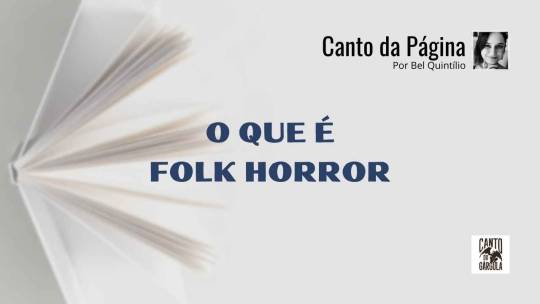
View On WordPress
#Alexander Meireles da Silva#Cinema#Coluna Canto da Página#Daniel Gruber#David Pinner#Folk Horror#H. P. Lovecraft#Irka Barrios#Lia Cavaliera#M. R. James#Margaret Alice Murray#Nathaniel Hawthorne#Sebo Clepsidra#Terror
0 notes
Text
Margaret Alice Murray "The Grandmother of Wicca"
Born July 13, 1863 in Calcutta, India to a British merchant father and his wife. She spent much of her youth traveling between India and England with her family.
In 1894, she began studying Egyptology at University College London. (UCL) She became a junior professor there in 1898.
From 1902-1903 she assisted William Matthew Flinders Petrie in his excavation in Abydos, Egypt
In 1908, she became the first woman to publicly unwrap a mummy with the unwrapping of Khnun-nakht
She was unable to return to Egypt due to World War I and put her focus into her witch-cult theories, on which I will elaborate below.
From 1921 to 1931, she undertook excavations in Malta and Menorca. During this time she developed an interest in folkloristics.
In 1927, she was awarded an honorary doctorate and in 1928 she was appointed Assistant Professor at UCL. She retired in 1935.
From 1935 until 1953 she continued her work in Egyptology including excavations in Petra, Jordan, lectures at the university, and cataloging antiquities.
In 1953, she became the President of the Folklore Society following the resignation of Allan Gomme.
She publicly supported the work of archaeologist T.C. Lethbridge and his claims that he had found three pre-Christian chalk hill figures. He in turn later showed public support for her witch-cult theories.
She celebrated her 100th birthday on July 13, 1963.
She passed away on November 13, 1963.
In Murray's book The Witch-Cult in Western Europe, she state there were two different types of Witchcraft. Firstly, there was what she called "Operative Witchcraft" which was how she referred to the creation of charms and casting of spells. Secondly, there was what she called "Ritual Witchcraft". This was supposed to be the ancient religion that was prevalent in Western Europe.
Murray made many claims on the deities that were worshiped by the cult, the organization, celebrations, and the focus of their practice. It was her theory that this cult had survived through the Christianization process of Britain to only be practiced in certain areas.
In her followup book, The God of the Witches, she began to refer to the cult as the "Old Religion". She expanded on her theories about the male deity which she had begun to call the "Horned God".
The reception of her first book started out with almost full support. Several early historians actually incorporated her theories into their own works. The thing was, none of these historians were experts in the witch trials. And the majority of them were experts in Early Modern Britain.
The experts in the Early Modern witch trials did not support her theories. Many completely tore apart her theories stating there was factual errors and that she lacked the methodology required to do accurate research on the subject. George L. Burr even went as far as to criticize the fact she took the confessions from accused witches as fact when they had been acquired with the use of torture and coercion. He was also one of the first to say she selectively picked the facts that would support her theories.
After Murray's passing in 1963, the criticism of her work increased. Research into the records of the witch trials increased as time had passed and it seemed to come to an almost unanimous agreement that the victims of the witch trials had not be practitioners of a pre-Christian religion. English historian Keith Thomas went as far to say that the evidence could not prove that any of the victims were actually devil-worshipers, as was the reason they were tried, or secret worshipers in a pagan cult. Many other historians cited the fact that her area of expertise was Egypt, not ancient Europe, and therefore her knowledge of English history was superficial.
Murray's theories seemed to become a blueprint of sorts for Wicca. Many of the original founders of Wicca claimed to be survivors of the witch-cult that Murray wrote about. The way covens were formed, the meetings at esbats and sabbats, the very worship of the male and female deity all seemed to be influenced by Murray's work. Murray herself wrote the forward in the original publication of Gerald Gardner's Witchcraft Today.
As her work came into question, many Wiccans distanced themselves from her theories. They acknowledge what research was proving and instead of her work being the literal history of Wicca, it came to be seen more as a mythology. However, there are still individuals to the day that believe her research was true and the work to discredit her was just another way of attempting to eradicate Pagans by Christians.
Now, do I believe the fact her work was discredited invalidates Wiccan beliefs and practices? No. Her research was flawed but it paved the way for those who believed in witchcraft to step forward and meet those that felt and believed the same way. That is how religions develop.
“Margaret Murray.” Wikipedia, Wikimedia Foundation, 14 Aug. 2021, en.wikipedia.org/wiki/Margaret_Murray.
Murray, Margaret A. The God of the Witches. Oxford University Press, 1970.
Murray, Margaret Alice. The Witch-Cult in Western Europe: A Study in Anthropology. Wentworth Press, 2019.
Sheppard, Kathleen L. The Life of Margaret Alice Murray a Woman's Work in Archaeology. Lexington Books, 2013.
1 note
·
View note
Photo

'Robin Goodfellow', ''The God of the Witches'' by Margaret Alice Murray, 1960
Source
#margaret alice murray#robin goodfellow#the gods of witches#witches#demonology#mythology#folklore#witchcraft
226 notes
·
View notes
Text
Familiars in History - Witch History
This post will take a look into the history of the witch’s familiar, where they came from, and how the idea of a familiar has evolved over time.
Edit: Please read my update post Familiar Spirits and The Witches' Familiar for more information on familiars in history! It's more in-depth and has more resources!
At last! I know a few of you have been waiting on this post, and I have been more than excited to research and write about this topic. I've done my best to keep it short and simple while still giving you resources to continue research on your own if you'd like.

Let’s first define familiars in modern witchcraft; Familiars are spirits that guide or help a witch either by protecting them, teaching them, aiding in magical affairs, or all of the above. This is a loose definition and may vary slightly depending on your beliefs.
This post is going to focus on the history of familiars, if you’d like to learn more about familiars in witchcraft and practice check out this post I made.
Etymology
The word familiar comes from the Latin familiaris meaning "of or belonging to the family". Familiaris likely came from the Latin word famulus meaning "slave" or "servant".
The earliest recorded use of the word familiar in reference to witchcraft came along in the 1580s whereas the term familiar spirit has been said to have been used in the 1560s. Familiars were often thought to be spirits inhabiting animals or demons that turn into animals. These familiars could be conjured by the witch or gifted to them by another witch or the Devil, none of this represents familiars as we know them today, of course.
One of the more popular of these animals being black cats.
Witch Trials
The idea of a familiar being a servant of some sort to a witch only started to appear after Christianity took hold which pushed the idea that anything that was not God or an Angel was considered evil or of the devil. This was especially prevalent during the time of witch trials including Europe’s witch trial and not just the more well known trials of Salem.
This is likely why many historical mentions of the word familiar in the context of witches talks about medieval times and witch trials; because the word wasn’t relevant, and probably didn’t exist in the same context before this time. This makes searching for pre-Christian information on familiars pretty impossible. However, this isn’t a post about the witch trials and I won’t write more on the topic of familiars in light of the trials in this post.
For more on this please read Guardian Spirit or Demonic Pets by James A. Serpell where he talks in great detail about witch’s familiars.
Margaret Alice Murray talks about two different kinds of familiars and how to obtain them in her book The Witch-Cult in Western Europe. This book is Murray’s interpretation of the evidence of Witch Trials in western Europe. It is certainly worth a read and has had an impact on how we think about familiars and witches today.
If you’re interested in learning more about the witch trials and what they truly were let me know and I will write a post about that as well.
Similarities and Comparisons
In the Christian Bible they are sometimes referred to as familiar spirits or imps, in Judaism they are called in a similar way. In Islam they may be associated with jinn. They are also equated to demons or devils throughout the Christianized Western cultures.
That being said, there are plenty of instances throughout history that predate the witch trials, where almost guardian-like beings similar to familiars are spoken about in a positive light.
Taking what we know about familiars now–referring to them as spirits that help and guide people–makes it much easier to find resources.
For instance, the Greeks believed in daimons which refers to supernatural beings between men and gods, such as minor gods or spirits of dead heroes. They had good (agathodaímōn or eudaimon) and bad daimons (kakodaimōn) as well as neutral, morally unspecified, daimons which were just called daimons. Some Greeks believed that you could have a personal daimon that would be a sort of guide or attendant.
Ancient Romans were more specific with names and had multiple genii that fall under the “helper spirit” category, such as Lares Familiares which were household deities or spirits that were guardians of the family.
Nordic folks had Fylgja, a guardian or “follower” spirit that was attached to a person related to their fate. These were often only seen by those with the ability to see the supernatural. In some cases they would foretell the death of the person who they followed but they weren’t inherently a sign of death. (Norse-mythology.org)
Even in Judaism and Christianity there exists the concept of gaurdian angels though the definition will vary by sect.
It could be said that Islam has a similar concept with beings called Mu'aqqibat, al-mu'aqqibat, that serve as guardians for humans like a guardian angel.
The term spirit guide has been used in more secular circles, meaning simply: an entity that remains as a discarnate spirit to act as a guide or protector to a living incarnated human being.
TL:DR
The definition of a witch's familiar has changed and evolved throughout time.
Familiars as we know them now are guides, helpers, protectors even, despite how the past has defined the word.
Celestial and spiritual guardians have existed for centuries, though they have been--and still are--called by many different names.
The reason it’s hard to find information about familiars in a non-witch trial context is because they weren’t relevant before the witch trials, and likely didn’t go by the name “familiar” at all.
Below are resources and further reading on the topics brought up in this post.
Resources and Citations
On Familiars
Familiar - Britannica
Etymology of Familiar
Notes on Familiars by Early Modern Whale
Guardian spirits or Demonic Pets by James A Serpell
On the Witch Trials
Witch Persecutions edited by George L. Burr.
Malleus Maleficarum or The Witch’s Hammer by Heinrich Kramer and Jacob Sprenger
The Witch-Cult in Western Europe by Margaret Murray
Misc
Encyclopedia of Demons in World Religions and Cultures by Theresa Bane
The Folklore of Isle of Man ch. III by A. W. Moore
Fylgja
Imp
If you see something inaccurate or incorrect, or if you have information to further the research of this post, please feel free to contact me and send me your resources so that I can edit or add to this post as needed.
-Coin
#familiars#familiar#witch's familiar#pagan#witchcraft#witchcraft history#history#witch trials#learning witchcraft
112 notes
·
View notes
Text
Women in Anthropology: MARGARET ALICE MURRAY
In the 100 years Margaret Murray was on this Earth she became a driving force for women in anthropology and in academia, earning the titles of archaeologst, Egyptologist, author, lecturer, Folkorist, and feminist.
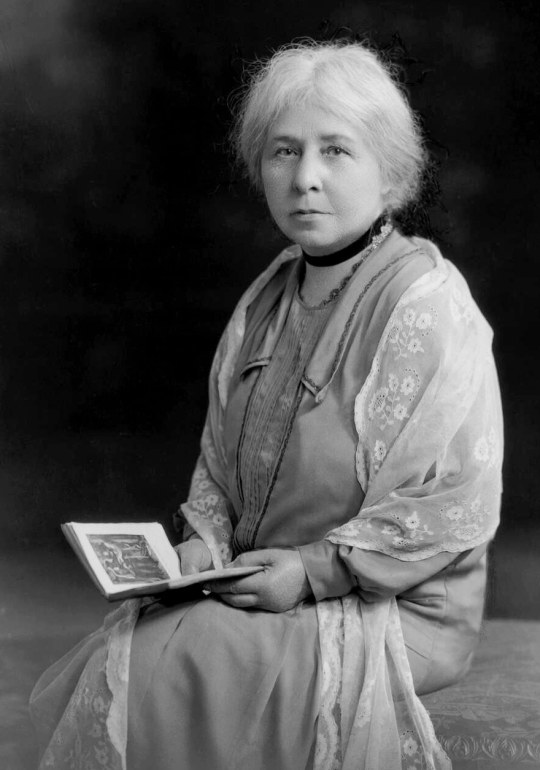
Murray was born to wealthy English parents in Calcutta, India in 1863. She spent her early years living in Britain and Germany before settling back in India as a nurse until 1887 when she moved to England and became a social worker.
She began attending the University College London (UCL) at the age of 31 in 1894 (proving that there is no set age to being your academic career) and by 1898 she was working as a junior lecturer of linguistics in the Egyptology department.
In 1902 she joined British Egyptologist Sir William Flinders Petrie for 2 field seasons in Egypt. During the first field season she helped to excavate a temple to Osiris, the Osireion, built during the New kingdom (roughly 16th to 11th century BCE) under the Pharaoh Seti I (pictured below).

After returning to London, she became a big supporter of the first wave feminist movement and joined the Women’s Social and Political Union. Murray initiated many campaigns to change the culture for women in academia and make it more accessible. At her insistence for inclusivity, the UCL common room was opened to women and later a redesigned room was constructed and named the Margaret Murray Room.
During World War I, she began studying and publishing articles and books on the history of witchcraft in Europe and Folklorism. Eventually, in 1927 she was awarded an honorary doctorate for her work in Egyptology. Throughout her career she wrote several books and many articles on Egyptology, Folklorism and also authored her own autobiography titled “My First Hundred Years” published in the year of her death 1963.
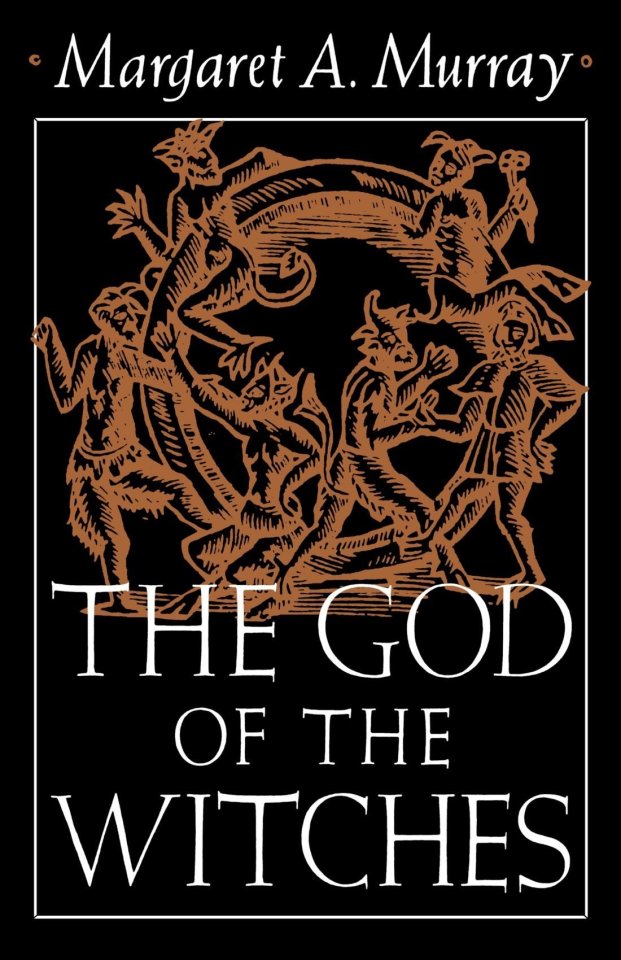
It is challenging for modern day academics to truly comprehend the different era and culture for a woman in anthropology during the late 19th to mid-20th centuries. Although, I am sure many of us agree that the academic climate of today oftentimes has much more progress to make. In any case, Margaret Murray was one of the first women to ‘make it’ within this scientific field dominated by a white men, and her contributions to academia were significant, well known, and respected.
However, this does not mean she was perfect. Much of her academic work and theory, especially in the field of Folklorism, is often criticized. Anthropology has changed quite a bit since Murray first entered the field over 158 years ago, and our views and methods of understanding are extremely different today.
What will not change is Murray’s solidified importance as an academic mind and as a woman in archaeology. She paved the way for other female scholars, and she fought for their advancement and their voices along the way.
Refs:
Drower, Margaret S. (2004). "Margaret Alice Murray". In Getzel M. Cohen; Martha Joukowsky (eds.). Breaking Ground: Pioneering Women Archaeologists. Ann Arbor: University of Michigan Press. pp. 109–141
Margaret Murray. (n.d.). Retrieved March 16, 2021, from https://www.fembio.org/english/biography.php/woman/biography/margaret-murray/
Margaret Murray. 25 Feb. 2021, en.wikipedia.org/wiki/Margaret_Murray.
"Margaret Murray". Stories From The Museum Floor, 2021, https://storiesfromthemuseumfloor.wordpress.com/2018/03/02/margaret-murray/.
---------------------------------------------------------------------------
About the podcast: The I Dig It Podcast was created by Alyssa and Michaela in March of 2020. Our goal for this podcast was to provide archaeology enthusiasts with insight into the student perspective of navigating the world of academia and the job market for archaeology and anthropology. Guests on the podcast include people from all different parts of their career, including highschool, undergrad, grad school, post doc, and early career!
Where to Find Us:
Insta: https://www.instagram.com/idigitpodcast/
Twitter: https://twitter.com/IDigItPodcast
Discord: https://discord.gg/T7BPe36
ArchPodNet: https://www.archaeologypodcastnetwork.com/idigit
How to get involved: Sign up to be a guest or to be featured on our social media pages https://linktr.ee/idigitpodcast
#women in science#anthropology#archaeology#history#womens history#women in archaeology#cultualanthropology#egypt#egyptology#margaret murray#Folklorism#feminist history#archaeologypodcastnetwork#womens history month#science#archaeology podcast#anthropologist#witchcraft#podcasts#ethnography
621 notes
·
View notes